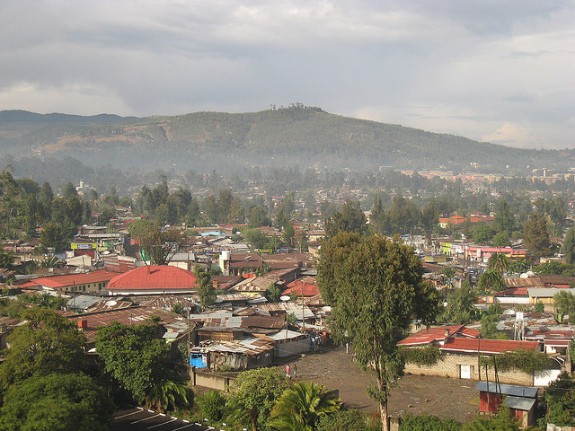Which Major Cities Are Leaders in Reducing Greenhouse Gas Emissions?
Research shows that cities can cut emissions by 70 percent; check out the ones striving their hardest to curb their carbon appetites
New York City is a leader in lowering greenhouse gas emissions. Photo by Flickr user Andrew C Mace
Cities are to greenhouse-gas emissions what Chernobyl was to nuclear power plant failures, which is to say, they’re the worst offenders out there. Cities consume two-thirds of the world’s energy and cough up 70 percent of global CO2 emissions. Some are even gaining notoriety: Air pollution in Beijing is so severe these days that residents can’t even escape it by going indoors, according to scientists at Columbia University’s Earth Institute.
But many cities are making progress in shrinking their greenhouse-gas footprints, and a recent new study shows that they can make reductions of as much as 70 percent. Scientists at University of Toronto’s Civil Engineering department used Toronto as a test piece for studying cities’ carbon footprints, and they outlined how changes in transportation, buildings and energy supplies–things like boosting insulation, switching to LED lighting and putting in building management systems and automatic lighting controls–can reduce emissions.
A 30 percent reduction would be fairly simple, the researchers say. “With current policies, especially cleaning of the electricity grid, Toronto’s per-capita GHG emissions could be reduced by 30 per cent over the next 20 years,” study author Chris Kennedy said in a statement. “To go further, however, reducing emissions in the order of 70 per cent, would require significant retrofitting of the building stock, utilization of renewable heating and cooling systems, and the complete proliferation of electric, or other low carbon, automobiles.”
Toronto has yet to begin adopting the plan Kennedy and his colleagues have outlined, but it is among the 58 city-members of the C40 Cities Climate Leadership Group, an organization committed to developing and implementing policies and practices to reduce greenhouse gas emissions. The group’s chair is New York City Mayor Michael Bloomberg, and in fact, New York is one of the most innovative and aggressive cities in the world when it comes to emissions reduction. “In my mind London and NYC are providing the greatest leadership,” Kennedy told Surprising Science.
Many other cities are also making strides, according to a 2011 study issued by C40 that details what its member-cities are doing to reduce their emissions. Forty major cities participated in the research, including Chicago, Houston, Los Angeles, Philadelphia and New York in the U.S., and cities from Moscow and Jakarta to Beijing and Mexico City internationally–many of the most populated, high-traffic urban centers in the world. Engineering and design firm Arup, along with the Clinton Climate Initiative, surveyed city officials and conducted research on their greenhouse-gas output and actions to reduce emissions.
Five cities stood out–here’s a breakdown of some highlights:
São Paulo: When landfills were reaching capacity in South America’s most populous city, the Brazilian metropolis installed thermoelectric power plants to capture and burn biogases emitted by the decaying waste. São Paulo’s 10 million citizens generate 15,000 tons of garbage each day, and trash is one of the city’s biggest greenhouse-gas challenges—as opposed to other cities, which struggle more with emissions from buildings and energy supplies. This step allowed São Paulo to reduce methane emissions and produce clean energy at the same time, and now 7 percent of the city’s electricity needs are met this way.
Copenhagen: Known for its bicycle culture, Denmark’s capital is a leader in green transportation, with 36 percent of work- or school-related commutes done by pedaling, according to the C40 study. Other cities have used Copenhagen as a model for their cycle parking, lanes, signage and other biking infrastructure. But Copenhagen is also a leader in waste management. Since 1988, it has reduced the amount of garbage it sends to landfills from 40 percent to less than 2 percent, and fully half of the city’s waste is recycled and used to generate heat. Nearly all of Copenhagen’s buildings (PDF) utilize an underground piping network that distributes hot water or steam in lieu of relying on boilers or furnaces. Citizens are required to pay for the heat regardless of whether they’re connected to the system.
Addis Ababa: In Ethiopia’s capital, shoddy water pipes are being replaced to help boost the city’s 50 percent leakage rate “Cities can lose huge amounts of their often energy-intensively produced potable water due to leakage from pipes during distribution,” the C40 study authors wrote. “Wasting potable water… increases greenhouse gas emissions, and is also a major issue for those cities that are threatened with droughts. The number of drought-threatened cities is rising due to climate change.”
That project joins large-scale, low-carbon housing developments that will create new homes for people currently living in Addis Ababa’s shanty towns, the C40 study showed. The city is also planning to convert 40 percent of its land to green space, which serves to absorb CO2 emissions and reduce the urban-heat-island effect. To that end, Addis Ababa’s mayor instituted a plan to plant three million new trees (the most ambitious tree-planting project in the world) and create a giant nature reserve featuring every tree and plant native to Ethiopia.

Ethiopia’s capital city Addis Ababa is shrinking its carbon footprint by building low-carbon, low-income housing and launching the most aggressive tree-planting program in the world. Photo by Flickr user Travlr
New York City: The city that never sleeps is a leader in green policy, according to the C40 study. Its PlaNYC, a program designed to reduce greenhouse gas emissions and otherwise prepare for climate change, includes planting trees and other vegetation to enhance 800 acres of parks and open spaces and pushing new development to areas with existing transit access so that new subway and bus lines don’t have to be added. The Greener Greater Buildings plan mandates upgrades to meet the NYC Energy Conservation Code for renovations, and the NYC Green Infrastructure Plan integrates details like green roofs and porous pavement into the city’s quest to manage storm runoff and alleviate pressure on wastewater treatment plants, which overflow in storms. New York is also known for its system of innovative pneumatic troughs that remove trash from Roosevelt Island through underground tunnels and eliminate the need for fleets of fossil-fuel-burning garbage trucks that clog traffic and wear down streets.
London: Greenhouse-gas reductions in the UK’s capital and largest city are impressive in part because it’s the only city to have achieved them “by diminishing consumption than a change of energy sources,” according to another study published last fall by Kennedy. His research showed that London was also the sole city where carbon emissions from commercial and institutional buildings have dropped. How did London make it happen? Establishing a so-called Congestion Charge Zone (PDF) was one key measure. A fee structure tied to emissions restricts the movement of freight and other heavy goods vehicles within the city’s center and allows electric vehicles to travel for free in the zone. The scheme, introduced in 2003, “has reduced vehicle numbers in the central business district by over 70,000 per day, cutting carbon emissions in the zone by 15%,” according to the study authors. Also, the city’s transit systems are integrated and easy to use thanks to a smart-ticket program, attracting more riders who might otherwise drive gas-guzzling cars.
While the overall effect of these emissions-reduction efforts hasn’t yet been measured, C40 study authors say the 40 cities have taken a combined total of 4,734 actions to tackle climate change. The simplest and most immediate change cities can make, according to Kennedy, is to decarbonize their electricity grids. “This is important because a low-carbon electricity source can be an enabler of low carbon technologies in other sectors, for example electric vehicles, or heating via ground source heat pumps,” he says. But the most effective change Kennedy recommends that city residents make in lowering their carbon footprints is to set their home thermostats 1 or 2 degrees lower in the winter or higher in the summer.
What does or could your city do to reduce its emissions? Leave us a note with your ideas!
